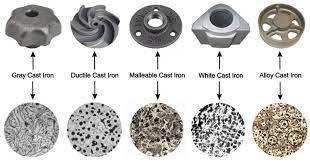Cast iron is a versatile and widely used material known for its exceptional strength, durability, and heat retention properties. It has been a staple in various industries and applications for centuries. To gain a deeper understanding of cast iron, it is essential to explore its different types and their unique characteristics. In this comprehensive guide, we will delve into the various types of cast iron, shedding light on their composition, properties, and common applications.
-
Gray Cast Iron:
Gray cast iron is one of the most common and recognizable types of cast iron. It owes its name to the grayish appearance of its fractured surface when it breaks. Gray cast iron is renowned for its excellent castability, good thermal conductivity, and dampening capacity. It is often used in engine blocks, pipes, and cookware due to its affordability and resistance to wear and corrosion.
-
White Cast Iron:
White cast iron is characterized by its white, crystalline fracture surface. This type of cast iron is exceptionally hard and brittle, making it unsuitable for most applications. However, it has high wear resistance, making it valuable for specialized uses like mill liners and crushing equipment.
-
Ductile Iron (Nodular Cast Iron):
Ductile iron, also known as nodular cast iron or spheroidal graphite iron, is a remarkable material that combines the strength of steel with the castability of iron. It is characterized by spherical graphite nodules within its microstructure, which give it improved ductility and toughness. Ductile iron is used in a wide range of applications, including pipes, automotive components, and construction materials.
-
Malleable Cast Iron:
Malleable cast iron is produced by annealing white cast iron, which makes it less brittle and more ductile. It can be easily machined and forged, making it suitable for components that require intricate shapes, such as ornamental ironwork, fittings, and plumbing parts.
-
Alloyed Cast Iron:
Alloyed cast iron is created by adding various alloying elements such as chromium, nickel, and molybdenum to the iron base. These alloys enhance the properties of cast iron, including corrosion resistance, heat resistance, and strength. Alloyed cast iron is often used in applications where specific performance characteristics are required, such as in the aerospace and automotive industries.
-
Chilled Cast Iron:
Chilled cast iron is produced by cooling the surface of the casting rapidly. This process results in a hard, wear-resistant outer layer while maintaining a ductile core. It is commonly used in rolls for rolling mills and brake drums, where both wear resistance and toughness are essential.
-
Vermicular Cast Iron:
Vermicular cast iron is known for its unique, partially vermicular graphite structure. It offers a balanced combination of strength and ductility, making it suitable for applications like engine blocks and brake discs.
-
Compacted Graphite Iron (CGI):
Compacted graphite iron is a relatively new type of cast iron that combines the best attributes of gray and ductile iron. It exhibits high strength, excellent thermal conductivity, and reduced weight, making it a preferred choice for engine blocks and other automotive components.
Conclusion:
Cast iron is a diverse family of materials, each with its own set of properties and applications. Understanding the different types of cast iron is crucial for selecting the right material for a specific purpose. Whether it's the versatility of gray cast iron, the strength of ductile iron, or the wear resistance of white cast iron, each type has its place in various industries and continues to play a vital role in engineering and manufacturing. This comprehensive guide provides a solid foundation for appreciating the versatility and significance of cast iron in today's world.


No comments yet